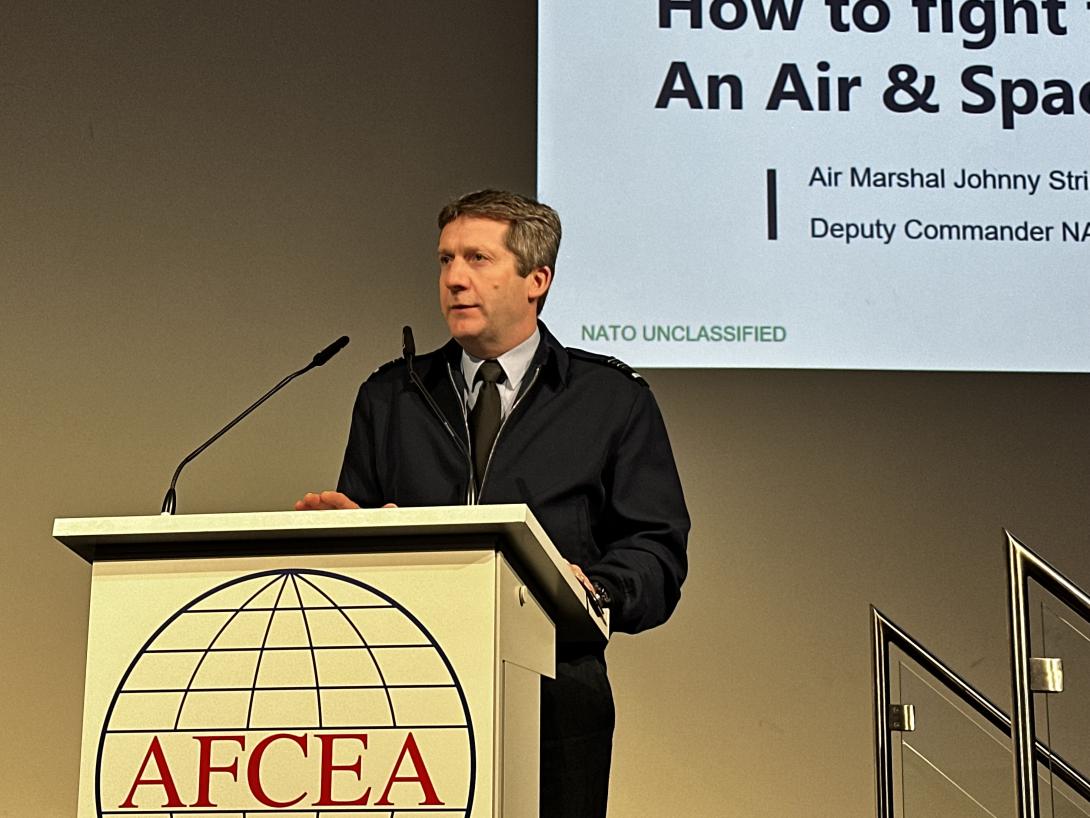Preparing To Fight Tomorrow in NATO Requires Advancements in Technology and Mindset
The NATO alliance faces challenges as it transforms its air and space capabilities to meet modern-day warfare. Many member nations are still set in the old processes and methods developed in the previous decades of unchallenged air superiority. However, the new era of contested, anti-access area denial operating environment requires fundamental shifts in both thinking and operations, advised the United Kingdom’s Royal Air Force Air Marshal Johnny Stringer, who is the NATO Allied Air Command deputy commander, speaking December 4 at AFCEA Europe’s TechNet Transatlantic conference in Frankfurt, Germany.
Air Marshal Stringer emphasized that the alliance’s military power has been influenced by two significant "long shadows"—the post-Cold War victory mindset and the focus on counterinsurgency operations in the Middle East. “Despite everything we say about digital and everything we say about the information age, are we still stuck in the industrial age when it comes to our processes, our thinking, our development and our procurement,” he said.
Modern-day warfare—as evident from the war in Ukraine—is showing NATO that it needs to reassess its approach to integrated air and missile defense. “The threat has evolved, particularly over the last seven to 10 years, out of all proportion to what people would have recognized probably even 15 years ago,” Air Marshall Stringer explained. “And what we need to be doing is recognizing that a good defense begins with a strong offense.”
One top priority: NATO needs to continue to modernize its command and control (C2) infrastructures, the deputy commander said.
The alliance is building on the concept of Combined Air Operations Centers (CAOCs), moving away from large, centralized facilities toward more distributed operational CAOCs. A third facility to aid its integrated air defense is planned in NATO’s Nordic countries in 2025, complementing the two existing CAOCs in Uedem, Germany, and Torrejón, Spain.
NATO’s digital capabilities and mindset, however, are lagging behind technological possibilities, Air Marshall Stringer warned. “We are not embracing the technology that we need to and my worry is that a lot of militaries—and this is a problem beyond just NATO—look like last followers, not first leaders in the digital space.”
Moreover, the use of fifth-generation aircraft—namely the F-35—requires a much tighter integration across nations, the deputy commander noted. With more than a dozen European countries flying F-35s—in addition to a cadre of fourth-generation fighters—NATO must develop more sophisticated and inclusive approaches to C2 and information sharing.
This includes how the allied nations handle the sharing of sensitive information.
The concept of agile combat employment, or ACE, has advanced in several countries, but it needs to move further across the entire NATO force structure. “We were really good at this, or at least some nations were really good at this back in the Cold War,” speaking to the dispersed, agile nature of forces, Air Marshall Stringer said. “But how many of you have just created a mental picture of fighter aircraft, when actually we need to be applying this to our tankers, to our ISR [intelligence, surveillance, reconnaissance], and to our airborne early warning systems.”
Nevertheless, the deputy commander warned that NATO’s current operations remain too similar to those during Operation Desert Storm. “I worry that a lot of what we do now is very recognizable from what we did in 1991,” he stressed.

We are not embracing the technology that we need to and my worry is that a lot of militaries—and this is a problem beyond just NATO—look like last followers, not first leaders in the digital space.
As such, commanders and staff must develop an innovative sense, and refrain from always saying “no.” Leadership training and development must prepare leaders for 2025 and beyond, not 1994.
“You are not going to achieve multidomain operations unless you do that,” Air Marshall Stringer said. “The best you will get is a kind of level of ‘joint-ery’ that we would recognize from 30 years ago,” he stated.
This also requires a shift in the risk-taking mindset, Air Marshall Stringer suggested. “You have got to look at risk in its broadest sense,” with mission-focused decision-making that considers the full spectrum of risks and benefits rather than focusing narrowly on individual risk factors.
In addition, for the 32-nation organization to succeed, member countries must make decisions to support NATO and bring consensus.
"There is huge strength in having 32 nations," he continued. "You trade that out at your peril, and getting agreement with all 32 is going to be a challenge [from time to time]. And we have to, as nations, accept at times that we might need to compromise on national positions to ensure that what is good for the alliance is actually done."
Together, the NATO countries must “harness the power of imagination, of innovation at the heart of it, all of the will to succeed,” he emphasized.
TechNet Transatlantic is organized by AFCEA International in conjunction with the AFCEA Europe office. SIGNAL Media is the official media of AFCEA International.






Comments